
A | B | C | D | E | F | G | H | CH | I | J | K | L | M | N | O | P | Q | R | S | T | U | V | W | X | Y | Z | 0 | 1 | 2 | 3 | 4 | 5 | 6 | 7 | 8 | 9
Campania | |
|---|---|
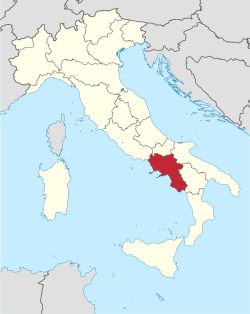 | |
| Coordinates: 40°54′38″N 14°55′14″E / 40.91056°N 14.92056°E[1] | |
| Country | |
| Capital | Naples |
| Government | |
| • President | Vincenzo De Luca (PD) |
| • Legislature | Regional Council |
| Area | |
| • Total | 13,671 km2 (5,278 sq mi) |
| Population (30 April 2023) | |
| • Total | 5,580,567 |
| • Density | 410/km2 (1,100/sq mi) |
| Demonyms | |
| GDP | |
| • Total | €110.231 billion (2021) |
| Time zone | UTC+1 (CET) |
| • Summer (DST) | UTC+2 (CEST) |
| ISO 3166 code | IT-72 |
| HDI (2021) | 0.856[3] very high · 19th of 21 |
| NUTS Region | ITF |
| Website | www |
Campania[a] is an administrative region of Italy; most of it is in the south-western portion of the Italian peninsula (with the Tyrrhenian Sea to its west), but it also includes the small Phlegraean Islands and the island of Capri. The capital of the Campania region is Naples.[6] As of 2018, the region had a population of around 5,820,000 people, making it Italy's third most populous region,[7] and, with an area of 13,590 km2 (5,247 sq mi), its most densely populated region. Based on its GDP, Campania is also the most economically productive region in southern Italy and the 7th most productive in the whole country. Naples' urban area, which is in Campania, is the eighth most populous in the European Union.[8] The region is home to 10 of the 58 UNESCO sites in Italy, including Pompeii and Herculaneum, the Royal Palace of Caserta, the Amalfi Coast, the Longobardian Church of Santa Sofia in Benevento and the Historic Centre of Naples. In addition, Campania's Mount Vesuvius is part of the UNESCO World Network of Biosphere Reserves.[9]
The Campania's hinterland was inhabited from the beginning of the 1st millennium BC by the Osci, Samnites and Etruscans, while between the 8th and 7th centuries BC its coastal areas were colonised by the ancient Greeks (Magna Graecia). At that time, Capua was Campania's leading city, while Naples was an anomaly, being predominantly Greek-speaking.[10]
Campania is rich in culture, especially with regard to food, music, architecture, and archaeological and ancient sites—such as Pompeii, Herculaneum, Oplontis, Paestum, Aeclanum, Stabiae, and Velia. The name "Campania" is derived from Latin; the Romans knew the region as Campania felix ("fertile countryside" or "happy countryside"). The rich natural beauty of Campania makes it important to the tourism industry: the city of Naples, the Amalfi Coast, Mount Vesuvius, and the islands of Capri and Ischia have long been major attractions.[11]
History
Pre-Roman period

The region known today as Campania was inhabited from at least the beginning of the 1st millennium BC by several Oscan-speaking Italic tribes: the Osci, the Opici, the Aurunci, the Ausones, the Sidicini, the Hirpini, the Caudini, the Oenotrians, the Campanians (after whom the region is named) and the Lucanians (who inhabited the southernmost part of Campania, known in ancient times as Lucania, roughly where modern-day Salerno is).[12][13] Many of these tribes lived in simple agro-towns. Not much is known about the pre-Indo-European tribes that had lived in the region earlier; they were probably not as technologically or culturally advanced as the Oscans, and any who still flourished had become fully Oscanised by the middle of the first millennium BC.
Between the 9th and 6th centuries BC, the Etruscans from Central Italy established colonies in the Campanian Plains (the inland territories that today are the provinces of Caserta and Naples), as well as in the regions of Agro Nocerino Sarnese and Agro Picentino (which today are in the province of Salerno). There, they essentially replicated their Dodecapolis (twelve cities) political model, founding the cities of Hyria (modern-day Nola), Irnthi or Marcina (modern-day Salerno), Amina (modern-day Pontecagnano Faiano), Velcha, Velsu and Uri. In addition to assimilating into their urban-political domains, the Etruscans also incorporated the pre-existing tribal Oscan agro-towns of Capua (modern-day Santa Maria Capua Vetere), Nuceria (modern-day comuni of Nocera Superiore and Nocera Inferiore), Suessula, Acerra, Ercolano, Pompeii, Stabiae and Sorrento.[14][15][16]
Meanwhile, during the 8th century BC, Greek-speaking people from Euboea (in Central Greece), known as Cumaeans, began to establish colonies themselves roughly around the coastal areas of the modern-day province of Naples and in the nearby islands founding, among others, the cities of Cumae, Pithekoūsai (modern-day Ischia), Paestum, Herculaneum and Dicaearchia, later 'Puteoli', in Latin (modern-day Pozzuoli). The city of Naples began as a small commercial port called Parthenope (Παρθενόπη, meaning "Pure Eyes", a Siren in Greek mythology), which was established by Greek colonial sailors from Rhodes.[17] The region thus became one of the centers of Magna Graecia.
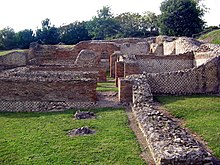
At one point in history, a distinct group of Oscan-speaking tribes from Samnium (in south-central Italy), the Samnites, moved down into Campania. Since the Samnites were more warlike than the other Oscan populations, they easily took over the cities of Capua and Cumae, in an area which was one of the most prosperous and fertile in the Italian Peninsula at the time.[18] During the 340s BC, the Samnites were engaged in a war with the Roman Republic in a dispute known as the Samnite Wars, with Rome claiming the rich pastures of northern Campania during the First Samnite War.[19] The First Samnite War was initiated when the Etruscan-influenced Oscan city of Capua (in Etruscan Capeva) was being attacked by the Samnites, and thus appealed to Rome for defensive help.
As the majority of Southern Italy was under Roman control at the time, the sole major remaining independent settlement in the region was the Greek colony of Neapolis, and when the city was eventually captured by the Samnites, the Neapolitan Greeks were left with no option but to call on the Romans, with whom they established an alliance, setting off the Second Samnite War.[18] The Roman consul Quintus Publilius Filo recaptured Neapolis by 326 BC and allowed it to remain a Greek city with some autonomy as a civitas foederata while strongly aligned with Rome.[20] The Second Samnite War ended with the Romans controlling all of southern Campania and additional regions further to the south, such as parts of Lucania.[19]
Roman period
Campania was a full-fledged part of the Roman Republic by the end of the 4th century BC, valued for its pastures and rich countryside. Naples, with its Greek language and customs, made it a centre of Hellenistic culture for the Romans, creating the first traces of Greco-Roman culture.[21] During the Pyrrhic War in 275 BC, the Battle of Beneventum took place in Campania in the Samnite city of Maleventum, in which the Romans, led by the consul Curius Dentatus, were victorious. They renamed it Beneventum (modern day Benevento), which grew in stature until it was second only to Capua in southern Italy.[22] During the Second Punic War in 216 BC, Capua, in a bid for equality with Rome, allied with Carthage.[23] The rebellious Capuans were isolated from the rest of Campania, which remained allies of Rome. Naples resisted Hannibal due to the imposing walls.[21] Capua was eventually starved into submission in the Roman retaking of 211 BC, and the Romans were victorious.[23]

With the initial exception of Naples, the region adopted Latin as official language, in that sense gradually replacing the native Oscan and the Greek and the Etruscan still talked respectively in their colonies of the region,[24][25][26] subsequently becoming fully Romanised.[27][28] As part of the Roman Empire, Campania, with Latium, formed the most important region of the Augustan divisions of Italia, the Regio I Latium et Campania; Campania was one of the main areas for granary.[28] In ancient times Misenum (modern 'Miseno'), at the extreme northern end of the bay of Naples, was the largest base of the Roman navy, since its port (Portus Julius) was the base of the Classis Misenensis, the most important Roman fleet. It was first established as a naval base in 27 BC by Marcus Agrippa, the right-hand man of the emperor Augustus. Roman Emperors chose Campania as a holiday destination, among them Claudius and Tiberius, the latter of whom is infamously linked to the island of Capri.[21] It was also during this period that Christianity came to Campania. Two of the apostles, St. Peter and St. Paul, are said to have preached in the city of Naples, and there were also several martyrs during this time.[29] The period of relative calm was violently interrupted by the epic eruption of Mount Vesuvius in 79 which buried the cities of Pompeii and Herculaneum.[30] With the Decline of the Roman Empire, its last emperor, Romulus Augustus, was put in a manor house prison near Castel dell'Ovo, Naples, in 476, ushering in the beginning of the Middle Ages and a period of uncertainty in regard to the future of the area.[21]
Feudalism in the Middle Ages
The area had many duchies and principalities during the Middle Ages, in the hands of the Byzantine Empire (also referred to as the Eastern Roman Empire) and the Lombards. Under the Normans, the smaller independent states were brought together as part of the Kingdom of Sicily, before the mainland broke away to form the Kingdom of Naples. It was during this period that elements of Spanish, French and Aragonese culture were introduced to Campania. Allegiances with the Muslim Saracens were made in 836, and the Arabs were requested to repel the siege of Lombard troops coming from the neighbouring Duchy of Benevento.[31][32]
The Kingdom
Norman to Angevin
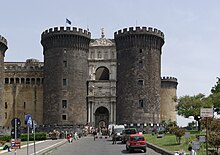
After a period as a Norman kingdom, the Kingdom of Sicily passed to the Hohenstaufens, who were a powerful Germanic royal house of Swabian origins.[33] The University of Naples Federico II was founded by Frederick II in the city, the oldest state university in the world, making Naples the intellectual centre of the kingdom.[34] Conflict between the Hohenstaufen house and the Papacy, led in 1266 to Pope Innocent IV crowning Angevin Dynasty duke Charles I as the king.[35] Charles officially moved the capital from Palermo to Naples where he resided at the Castel Nuovo.[36] During this period, much Gothic architecture sprang up around Naples, including the Naples Cathedral, the main church of the city.[37]
In 1281, with the advent of the Sicilian Vespers, the kingdom split in half. The Angevin Kingdom of Naples included the southern part of the Italian peninsula, while the island of Sicily became the Aragonese Kingdom of Sicily.[35] The wars continued until the peace of Caltabellotta in 1302, which saw Frederick III recognised as king of the Isle of Sicily, while Charles II was recognised as the king of Naples by Pope Boniface VIII.[35] Despite the split, Naples grew in importance, attracting Pisan and Genoese merchants,[38] Tuscan bankers, and with them some of the most championed Renaissance artists of the time, such as Boccaccio, Petrarch and Giotto.[39] Alfonso I conquered Naples after his victory against the last Angevin king, René, and Naples was unified for a brief period with Sicily again.[40]
Aragonese to Bourbon

Sicily and Naples were separated in 1458 but remained as dependencies of Aragon under Ferrante.[41] The new dynasty enhanced Naples' commerce by establishing relations with the Iberian peninsula. Naples also became a centre of the Renaissance, with artists such as Laurana, da Messina, Sannazzaro and Poliziano arriving in the city.[42] During 1501 Naples came under direct rule from France at the time of Louis XII, as Neapolitan king Frederick was taken as a prisoner to France; this lasted four years.[43] Spain won Naples at the Battle of Garigliano and, as a result, Naples then became part of the Spanish Empire throughout the entire Habsburg Spain period.[43] The Spanish sent viceroys to Naples to directly deal with local issues: the most important of which was Pedro Álvarez de Toledo, who was responsible for considerable social, economic and urban progress in the city; he also supported the Inquisition.[44]
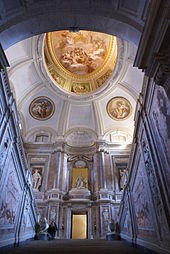
During this period Naples became Europe's second largest city after Paris.[45] During the Baroque era it was home to artists including Caravaggio, Rosa and Bernini; philosophers such as Telesio, Bruno, Campanella and Vico; and writers such as Battista Marino. A revolution led by local fisherman Masaniello saw the creation of a brief independent Neapolitan Republic, though this lasted only a few months before Spanish rule was regained.[43] Finally, by 1714, the Spanish ceased to rule Naples as a result of the War of the Spanish Succession; it was the Austrian Charles VI who ruled from Vienna, similarly, with viceroys.[46] However, the War of the Polish Succession saw the Spanish regain Sicily and Naples as part of a personal union, which in the Treaty of Vienna were recognised as independent under a cadet branch of the Spanish Bourbons in 1738 under Charles VII.[47]
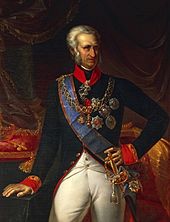
During the time of Ferdinand IV, the French Revolution made its way to Naples: Horatio Nelson, an ally of the Bourbons, even arrived in the city in 1798 to warn against it. However, Ferdinand was forced to retreat and fled to Palermo, where he was protected by a British fleet.[48] Naples' lower classes (the lazzaroni) were pious and Royalist, favouring the Bourbons; in the mêlée that followed, they fought the Neapolitan pro-Republican aristocracy, causing a civil war.[48] The Republicans conquered Castel Sant'Elmo and proclaimed a Parthenopaean Republic, secured by the French Army.[48] A counter-revolutionary religious army of lazzaroni under Fabrizio Ruffo was raised; they had great success and the French surrendered the Neapolitan castles and were allowed to sail back to Toulon.[48]
Ferdinand IV was restored as king; however, after only seven years Napoleon conquered the kingdom and instated Bonapartist kings including his brother Joseph Bonaparte.[49] With the help of the Austrian Empire and allies, the Bonapartists were defeated in the Neapolitan War and Bourbon Ferdinand IV once again regained the throne and the kingdom.[49] The Congress of Vienna in 1815 saw the kingdoms of Naples and Sicily combined to form the Two Sicilies,[49] with Naples as the capital city. Naples became the first city on the Italian peninsula to have a railway in 1839,[50] there were many factories throughout the kingdom making it a highly important trade centre.[51]
World War II
In September 1943, Salerno was the scene of Operation Avalanche and suffered a great deal of damage. From 12 February to 17 July 1944, it hosted the Government of Marshal Pietro Badoglio. In those months Salerno was the temporary "Capital of the Kingdom of Italy", and the King Victor Emmanuel III lived in a mansion in its outskirts. Salerno received the first "Tricolore" in an official ceremony on 7 January 2012 from the premier Mario Monti, to celebrate the glorious story of Italy and its old capitals.
Geography
Campania has an area of 13,590 km2 (5,247 sq mi) and a coastline of 500 km (311 mi) on the Tyrrhenian Sea.[52] Campania is famous for its gulfs (Naples, Salerno and Policastro) as well as for three islands (Capri, Ischia and Procida).
Four other regions border Campania; Lazio to the northwest, Molise to the north, Apulia (Puglia) to the northeast and Basilicata to the east.
The mountainous interior is fragmented into several massifs, rarely reaching 2,000 m (6,562 ft) (Miletto of 2,050 m (6,726 ft)),[53] whereas close to the coast there are volcanic massifs: Vesuvio (1,281 m (4,203 ft))[54] and Campi Flegrei.
The climate is typically Mediterranean along the coast with warm, sunny and sultry summers and mild, rainy winters, whereas in the inner zones it is more continental, with lower temperatures in winter and warm summers. Snow is possible at higher elevations but rare at sea level. 51% of the total area is hilly, 34% mountainous and the remaining 15% is made up of plains.[55] There is a high seismic risk across the region.
-
Naples (Nunziatella Military School)
-
Island Capri
-
Island Ischia
-
Typical landscape in Province of Avellino, also known as Irpinia
-
Canyons of Forre del Titerno, Province of Benevento
Economy
The GDP per capita in Campania is rank 18 from 20 Italian regions, surpassing only Sicily and Calabria.[56] It is only 66.7% of the Italian average. It has been speculated that a factor could be the failure to connect the region's economy with the rest of Italy, while another factor could be its peripheral position with respect to the developed central areas of Europe.[57]
Overall, Campania appears to be a region with great economic potential, which is partly held back by organized crime (Camorra) and the resulting corruption.[58] The economy of Campania is one of the most affected nationwide by the economic and financial crisis that began in 2008,[59] but between 2015 and 2016 it came out of the recession and began to recover due to, above all, industry, but also tourism and tertiary.[60]
Tourism

Tourism is supported by the abundant presence of artistic and naturalistic beauty which attract millions of people from all over the world every year. Precisely in this sector the region finds its strong point (through which it was able to react to the recession in 2015), in fact, according to 2018 studies done by Eurostat, Campania is in the top 20 of the most visited regions in Europe and fifth in Italy after Lombardy, Lazio, Veneto and Tuscany (in order), as well as first among the southern regions.[61]
The tourist flow sees more than half of the Italian and foreign tourists of the entire region gather in the Metropolitan City of Naples.[62] Of all the locations, Pompeii and Herculaneum stand out, two of the most visited archaeological sites in Italy and among the most visited in the world where there is an average of four million tourists a year.[63] Then there are the Campanian Archipelago (Capri, Ischia and Procida, the latter named Italian capital of culture in 2022), Vesuvius and the Sorrento coast; a notable growth in the cruise sector was observed in the Port of Naples.[64]
Tourist data on other sites in Campania show important records that the region holds nationally and worldwide. Among these above all the data relating to Capri (which is the most visited minor island in Italy and among the most sought-after in the world),[65] the Amalfi Coast (which is among the most visited sites in Italy)[66] and finally Vesuvius (the most visited and well-known volcano in the world).[67][68] There is also a growing influx of tourists to Cilento (Paestum and Certosa di Padula.[69]
Campania has many small and picturesque villages, 11 of them have been selected by I Borghi più belli d'Italia (English: The most beautiful Villages of Italy),[70] a non-profit private association of small Italian towns of strong historical and artistic interest,[71] that was founded on the initiative of the Tourism Council of the National Association of Italian Municipalities.[72]
Decline of heavy industry

Campania is traditionally the most industrialized region of southern Italy, particularly the Neapolitan territory was one of the most industrialized areas of Italy until the beginning of the 20th century, preceded only by the provinces of the so-called "industrial triangle" (Milan, Turin and Genoa).[73]
In recent decades, the gap with respect to other regions is no longer as significant as it used to be, given that southern regions such as Apulia and Abruzzo have grown considerably economically, while Campania has paradoxically undergone a constant process of de-industrialisation. The symbol of this phenomenon is the reclamation process of the area in Bagnoli where the former Italsider and Eternit operated promoted by the region.[74]
Food and agriculture
Campania mainly produces fruit and vegetables, but has also expanded its production of flowers grown in greenhouses, becoming one of the leading regions of the sector in Italy.[75] In 2021 the value added of this sector represents around 2.34% of the total value added of the region, equalling €2.2 billion.[76] Campania produces over 50% of Italy's nuts and is also the leader in the production of tomatoes.[77]
Typical products are:
-
Apple "Annurca" with distinctive ripening process
-
Vesuvian apricot
-
Neapolitan peach
-
Huge lemon of Sorrento and Amalfi Coast
-
Sorrento orange
-
White fig of Cilento
-
San Marzano tomato
-
Pasta of Gragnano
-
Liqueur "Limoncello"
A distinctive point of regional agriculture in the breeding of buffalos. The milk is used to produce mozzarella di bufala.
Olive trees, mainly of the varieties Carpellese (PDO designated),[78] Cornia (Val di Cornia DOC), Frantoio, Leccino, Ogliarola Barese, Olivella, Ortice, Pisciottana (Also Ogliastrina or Olivo dell'Ascea),[79] Ravece (also known as Rotondello),[80] and Salella,[81] covers over 74,604 hectares (184,350 acres).
Vineyards cover 41,129 ha, but only ca. 5,100 ha using to produce quality wine of DOC and DOCG types. There are 4 DOCG wines: Aglianico del Taburno (red and rose), Fiano di Avellino (white), Greco di Tufo (white and sparkling) and Taurasi (red). Wine production has increased as well as the quality of the wine.[82]
There is a problem with illegal toxic waste dump in the Triangle of death north of Naples between Acerra, Nola and Marigliano.[83][84] In the region, over 12,000 cattle, river buffaloes and sheep had been culled before 2006.[85] High levels of mortality and abnormal foetuses were also recorded in farms in Acerra linked to elevated levels of dioxin.[85] Local studies have shown higher than permissible levels of lead in vegetables grown in the area.[86] The government blames the Mafia's illegal garbage disposal racket.[86] In samples of milk, which is using to produce mozzarella di bufala, found cancerogenic dioxine.[87] In Naples-Bagnoli is an asbestos contamination from former Eternit cement plant.[88] Millions of tons of toxic industrial waste has been dumped in Campania, not only in the Triangle of death, a region once celebrated for the fertility of its soil, but now the local population have been exposed to land contaminated with waste. This includes highly dangerous materials such as asbestos, zinc, lead, germanium, arsenic, mercury, cadmium, chromium, dioxin and uranium. Blood tests of people living in Campania show alarming levels of dioxins.[89]
Automotive
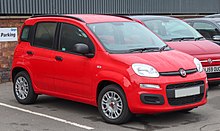
Campania had a massive automotive industrial production till 2011, focused on Alfa Romeo.[90] Production of Alfa Romeo was reduced and relocated to plant in Cassino near Rome. Currently only one low-level Fiat Panda model is produced in facilities located in Pomigliano d'Arco in the Naples metropolitan area (140,478 units in 2020).[91] A FIAT plant manufacturing engines is in Pratola Serra, Avellino. There are also plants for automotive parts suppliers like Magneti Marelli (exhaust systems) and Denso (engine cooling and air-conditioners). Buses are produced by Industria Italiana Autobus in Flumeri (ex-Irisbus).
Aerospace and rail
There is also a significant aerospace industry:
- A failed Mars mission named ExoMars in 2016 had a major part of its technology designed in Naples[92] No signal indicating a successful landing was received.[93]
- Also in Pomigliano d'Arco there are a Leonardo plant, which produces the fuselage and tail of ATR planes[94] and an Avio Aero plant, which manufactures parts of gas turbines. Benevento has a Leonardo Helicopters plant (aluminum and magnesium castings)[94]
- Radars for military and air traffic control applications and components are produced by two other Leonardo establishments in Giugliano in Campania and Bacoli[94]
- Vulcanair in Casoria manufactures light aircraft
- Seekers for missiles are made in Bacoli-Fusaro by MBDA
Hitachi Rail Italy has headquarters, manufacturing plant and service facilities in Naples. Here it produces the metro trains Meneghino and Driverless Metro.[95]
Fashion
Luxury brands like Kiton, Cesare Attolini, Isaia, Rubinacci, Harmont & Blaine, E. Marinella are also located in Campania. All of them are relative small-sized with annual sales of less than 100 million euros each.
Other industrial districts
There are other industrial districts in Campania:

- Jewelry in Marcianise, one of the four located in Italy. It has 350 companies with ca. 2500 employees, and the annual turnover is 750 million euros. Every two years there is a special fair.
- Coral products, cameos and nacre in Torre del Greco. Since 1989 in Torre del Greco coral fishing is not practised, but the town still remains the most important centre in the world for coral processing, with over 2,000 employees in the sector.
- Leather tanning in Solofra extends over an area of about 60 km2 in the south-western area of the province of Avellino, including also Montoro and Serino. This area is specialized in the tanning of sheep and goatskins, for a total of about 400 companies operating in the sector including tanneries, subcontractors and garment manufacturers, 4,000–4,500 employees and an average annual turnover of 1,500 million euros. It specializes in the processing of leathers for clothing, shoes and leather goods.
- Shoe making in Grumo Nevano, Aversa, Trentola Ducenta
Transport
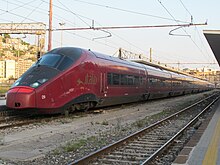
The region has a dense network of roads and motorways, a system of maritime connections and an international airport (Naples Airport). The port of Naples connects the region with the Mediterranean basin, and brings tourists to the archaeological sites, the cities of art (Naples and Caserta), to the coastal areas and to the islands.
Rail
There are high-speed rail lines:
There is a maintenance and service centre for high-speed trains Alstom AGV in Nola.
Maritime
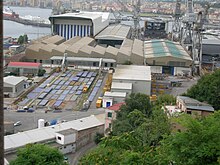
Sea-based activity accounts for about 3.9% of the economy, which includes port movements of goods and passengers and sea transportation, as well as a sizable seaside tourism economy. In Castellammare di Stabia there is a big Fincantieri shipyard. Shipping companies Grimaldi and Tirrenia both headquarter in Naples.
Service
The services sector makes up for 78% of the region's gross domestic product.[82]
Unemployment
The unemployment rate stood at 17.4% in 2022 and was one of the highest in Italy.[96]
| Year | 2006 | 2007 | 2008 | 2009 | 2010 | 2011 | 2012 | 2013 | 2014 | 2015 | 2016 | 2017 | 2018 | 2019 | 2020 | 2021 | 2022 |
|---|---|---|---|---|---|---|---|---|---|---|---|---|---|---|---|---|---|
| unemployment rate (in %) |
12.8% | 11.2% | 12.5% | 12.9% | 13.9% | 15.4% | 19.2% | 21.5% | 21.7% | 19.8% | 20.4% | 20.9% | 20.4% | 20.0% | 17.9% | 19.3% | 17.4% |
Demographics
| Year | Pop. | ±% |
|---|---|---|
| 1861 | 2,402,355 | — |
| 1871 | 2,520,095 | +4.9% |
| 1881 | 2,659,688 | +5.5% |
| 1901 | 2,914,073 | +9.6% |
| 1911 | 3,101,593 | +6.4% |
| 1921 | 3,343,293 | +7.8% |
| 1931 | 3,508,774 | +4.9% |
| 1936 | 3,696,632 | +5.4% |
| 1951 | 4,346,264 | +17.6% |
| 1961 | 4,760,759 | +9.5% |
| 1971 | 5,059,348 | +6.3% |
| 1981 | 5,463,134 | +8.0% |
| 1991 | 5,630,280 | +3.1% |
| 2001 | 5,701,931 | +1.3% |
| 2011 | 5,766,810 | +1.1% |
| 2021 | 5,624,420 | −2.5% |
| Source: ISTAT | ||
The region, with a population of over 5.8 million inhabitants, is divided into five provinces: Naples, Benevento, Avellino, Caserta and Salerno. Over half of the population is resident in the province of Naples, where there is a population density of 2,626 inhabitants per km2. Within the province, the highest density can be found along the coast, where it reaches 13,000 inhabitants per km2 in the city of Portici. The region, which was characterised until recently by an acute economic contrast between internal and coastal areas, has shown an improvement in the last decade thanks to the development of the provinces of Benevento and Avellino. At the same time, the provinces of Naples, Caserta and in part Salerno, have developed a variety of activities connected to advanced types of services.[97]
Immigration and ethnicity
| Nationality | Population |
|---|---|
| 37,834 | |
| 33,334 | |
| 23,252 | |
| 16,506 | |
| 11,896 | |
| 8,648 | |
| 8,147 | |
| 7,966 | |
| 7,689 | |
| 6,855 |
Unlike central and northern Italy, in the first decade of the 2000s the region of Campania has not attracted large numbers of immigrants, despite having increased from approximately 100,000 in 2007 to 240,000 in 2021. The Italian national institute of statistics ISTAT estimated in Dicember 2022 that 241,008 foreign-born immigrants live in Campania, equal to 4.32% of the total regional population.[99] Part of the reason for this is in recent times, there have been more employment opportunities in northern regions than in the Southern Italian regions.
Government and politicsedit
The Politics of Campania, takes place in a framework of a presidential representative democracy, whereby the President of Regional Government is the head of government, and of a pluriform multi-party system. Executive power is exercised by the Regional Government. Legislative power is vested in both the government and the Regional Council.
The Regional Council of Campania (Consiglio Regionale della Campania) is composed of 60 members, of which 47 are elected in provincial constituencies with proportional representation, 12 from the so-called "regional list" of the elected president and the last one is for the candidate for president who comes second, who usually becomes the leader of the opposition in the council. If a coalition wins more than 55% of the vote, only 6 candidates from the "regional list" will be elected and the number of those elected in provincial constituencies will be 53.[100]

Administrative divisionsedit
Campania is divided into four provinces and one metropolitan city:
| Province | Area (km2) | Population | Density (inhabitants/km2) |
|---|---|---|---|
| Province of Avellino | 2,792 | 427,310 | 153 |
| Province of Benevento | 2,071 | 283,393 | 136.83 |
| Province of Caserta | 2,639 | 906,596 | 343.54 |
| Province of Salerno | 4,923 | 1,092,349 | 222.11 |
| Metropolitan City of Naples | 1,171 | 3,052,763 | 2,606.97 |
Cultureedit
Cuisineedit
Zdroj:https://en.wikipedia.org?pojem=Campania_(Roman_province)Text je dostupný za podmienok Creative Commons Attribution/Share-Alike License 3.0 Unported; prípadne za ďalších podmienok. Podrobnejšie informácie nájdete na stránke Podmienky použitia.
Antropológia
Aplikované vedy
Bibliometria
Dejiny vedy
Encyklopédie
Filozofia vedy
Forenzné vedy
Humanitné vedy
Knižničná veda
Kryogenika
Kryptológia
Kulturológia
Literárna veda
Medzidisciplinárne oblasti
Metódy kvantitatívnej analýzy
Metavedy
Metodika
Text je dostupný za podmienok Creative
Commons Attribution/Share-Alike License 3.0 Unported; prípadne za ďalších
podmienok.
Podrobnejšie informácie nájdete na stránke Podmienky
použitia.
www.astronomia.sk | www.biologia.sk | www.botanika.sk | www.dejiny.sk | www.economy.sk | www.elektrotechnika.sk | www.estetika.sk | www.farmakologia.sk | www.filozofia.sk | Fyzika | www.futurologia.sk | www.genetika.sk | www.chemia.sk | www.lingvistika.sk | www.politologia.sk | www.psychologia.sk | www.sexuologia.sk | www.sociologia.sk | www.veda.sk I www.zoologia.sk
























